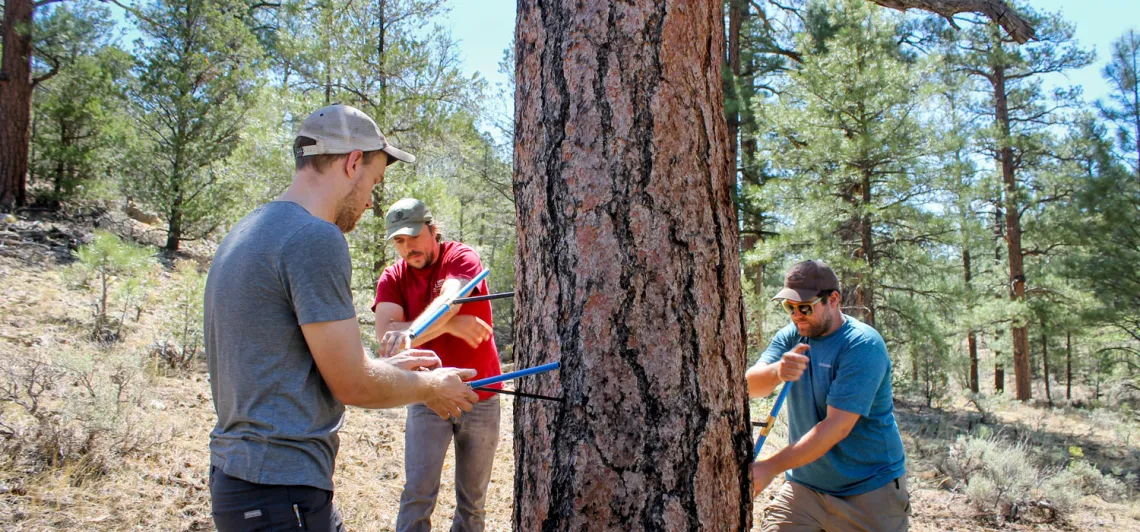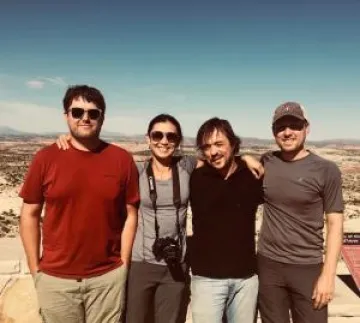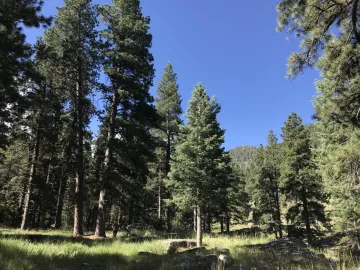Chasing a Storm in the Pines
The monsoon is here, and UA scientists are traveling to Ponderosa pine forests in Arizona and southern Utah to learn how trees in the southwest weather the storm.

Matt Dannenberg, Paul Szejner, and Erik Anderson core a Ponderosa pine tree in Northern Arizona's Kaibab National Forest. (Photo: Emily Litvack/RDI)
Emily Litvack/RDI
A dusty Dodge Caravan rolls up a dirt road. The scientists park at a campsite and unload a cooler, a plastic tub full of wood slivers called “cores,” a few tools used to gently pluck cores from pine trees, a box of glass vials, a roll of blue tape, and a permanent marker. Here, in the Kaibab National Forest along the south rim of Grand Canyon, they’ll take cores from 25 mature, healthy trees before doing the four-hour-long trek back to the lab in Tucson.
The team of University of Arizona scientists includes Assistant Professor of Riparian Ecology Jia Hu, Research Specialist Erik Anderson, and Postdoctoral Research Associates Matthew Dannenberg and Paul Szejner.
This is the last of the seven sites they’ve visited over the course of eight days. They’re ready for a real shower and a long nap, they say, but enthused about all they accomplished—that is, bringing pieces of nearly 200 Ponderosa pine trees back to the UA’s Laboratory of Tree Ring Research for study.
The goal: using tree rings to better understand the North American monsoon. How far north has the monsoon travelled over time? Has it changed much? How does it drive and stall the growth of pine forests in the region? It’s chemical detective work, because the answers are all recorded—in the form of oxygen and carbon—in the rings of trees.
Hu, Anderson, Dannenberg, and Szejner begin walking through the forest, sizing up the Ponderosa pine trees. They need ones that look big and healthy enough to make good samples. For fun, they guess what the diameter of a tree will be before measuring it (Hu gets one right on the money). They race to see who can twist a core out of a tree fastest (Szejner, most of the time). When they’ve got samples from six trees, Anderson jokes, “We’re a core-ter of the way done.”

From left to right: Erik Anderson, Jia Hu, Paul Szejner, and Matt Dannenberg at Grand Staircase-Escalante National Monument during their fieldwork travels this summer.
When they’ve finished, they wander back to the campsite and settle into chairs for a lunch of carrots, hummus, and pita bread. They reflect on the time they’ve spent collecting data over the last week.
“With this project we’re looking at the annual variation of the monsoon in this region, how far north it goes, and how long it takes for a tree to recover after an extreme event,” says Szejner.
Climate variation, including extreme events like drought, is a matter of life and death for Ponderosa pine trees, which are widespread across the southwest. People often assume it’s a decrease in rain over the years that’s causing the demise of more and more pine trees but, in fact, it’s not that the southwest is getting less rain—it’s just becoming more arid.
“If we look at the last 100 years, there’s been a lot of variability, but we’re not getting less precipitation,” says Hu. “And total annual precipitation alone isn’t always enough to predict tree mortality. Aridity is a big, important culprit.”
“And even if the mean precipitation hasn’t changed much over the last century, how it’s distributed is changing,” says Dannenberg.
And that matters because, plain and simple: Climate extremes like bone-dry summers are quickly becoming the norm.
“Now we see extremes every three years or so,” says Szejner.
Increased aridity of the region is bad news for trees. Dry air makes it harder for them to transport nutrients from roots to needles, harder for them to grow, and makes their leaves dry out. Tree health depends largely on moisture in the air, so, unsurprisingly, the humid climate during monsoon season helps them thrive.
“We owe the Sonoran Desert to the monsoon. It’s a very distinct source of moisture during the summer. Without it, the Sonoran wouldn’t exist,” says Szejner.
“The monsoon is a really unique feature of the climate system in the southwest and a really important water source here,” says Hu.
Because they’re always chemically recording information about their environment, the team can track the effect aridity has had on Ponderosa pine trees for as long as they’ve been alive—sometimes 100 or 200 years.

The team visited a site called Pine Valley in Utah's Dixie National Forest.
“Aridity is the main variable we’re after,” says Szejner.
The trees put on annual rings that are related to precipitation. The wider the ring, the more rain fell that year. When they take the cores back to the lab for analysis, the team will measure the amount of oxygen and carbon isotopes in tree rings across seasons, first, by carefully slicing each ring into three pieces where the wood looks distinctly different. For example, wood in the late summer looks dark and dense while monsoon-time wood appears pale. Where Szejner sees those shifts in appearance is where he’ll slice each ring. It’s meticulous, like a surgery, but useful.
“By capturing seasonality, we’ll highlight the sensitivities of these trees even at the sub-annual scale,” says Hu. It’s something that the scientific community hasn’t done much but could provide very important information in a region like the American southwest, where monsoon reigns supreme.
The “sensitivities” will appear as varying levels of oxygen and carbon isotopes. The fibers of these tree trunks records the chemical composition of their source water (such as rainfall) exactly as it came to the tree. By the time it gets to the pine needles, that water appears different. That change depends on aridity of the atmosphere. When it’s especially dry, the needles will have a lower oxygen-16/oxygen-18 ratio compared to when it’s wetter, because oxygen-16 is lighter and easier for the tree to transpire.
Because the data on Ponderosa pine needle isotopes is already plentiful, the team will be able to compare exactly how different the source water in tree rings is from the water in pine needles. That difference shows what kind of effect aridity had on the tree that season.
“We might also be able to say that trees in the southwest with a constant monsoon, like those in Tucson, will be better off than those that don’t, like in Flagstaff,” says Szejner.
Not only will their findings offer a fresh perspective on the future of our forests, but it has potential to be extremely valuable to forest managers, who could use the information to make decisions that preserve the forests.
“We can identify populations of trees that are vulnerable before they die because we’ll see exactly how sensitive they are to aridity based on the tree ring data,” says Hu.
“So if I’m a forest manager, I have an early alert for tree mortality and I can say, ‘Let’s clean this forest to reduce the amount of water it needs and we can get more water in the soil for the trees that need it,’” says Szejner.
The controlled burns Szejner is referring to come with the added benefit of reducing risk of wildfire.
Their work, funded for three years by the National Science Foundation, will take them right back to this Kaibab campsite in August, when they plan to resample the same seven sites, after the monsoon has come and gone.
Until then, they take their showers indoors, drive on paved roads, and toil in the lab.

